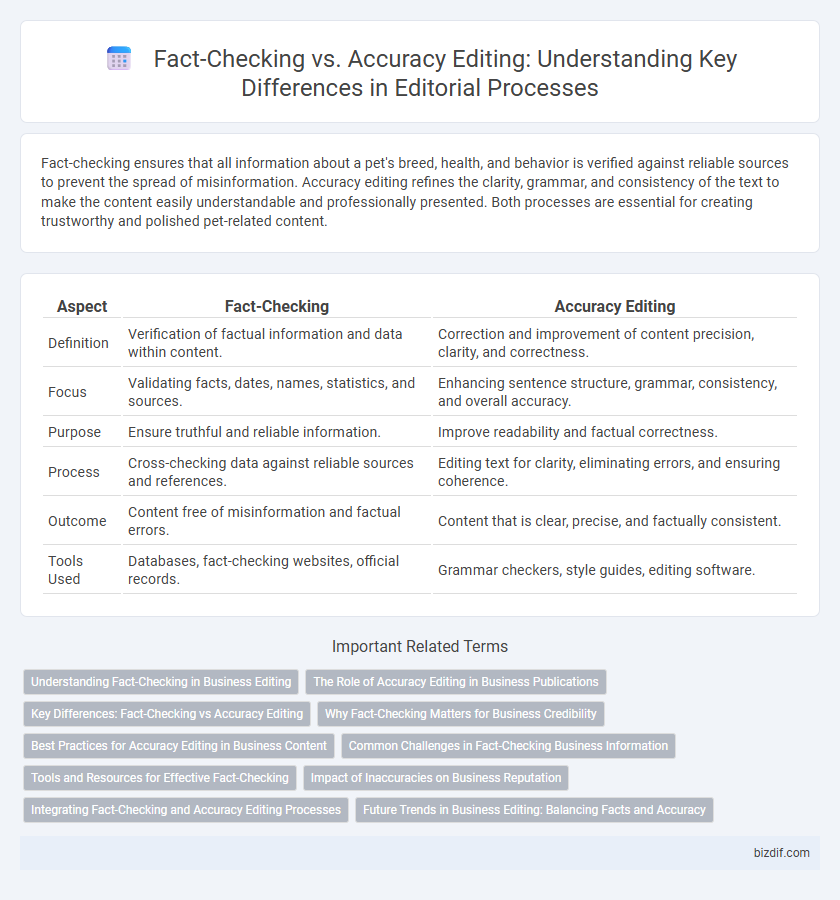Fact-checking ensures that all information about a pet's breed, health, and behavior is verified against reliable sources to prevent the spread of misinformation. Accuracy editing refines the clarity, grammar, and consistency of the text to make the content easily understandable and professionally presented. Both processes are essential for creating trustworthy and polished pet-related content.
Table of Comparison
| Aspect | Fact-Checking | Accuracy Editing |
|---|---|---|
| Definition | Verification of factual information and data within content. | Correction and improvement of content precision, clarity, and correctness. |
| Focus | Validating facts, dates, names, statistics, and sources. | Enhancing sentence structure, grammar, consistency, and overall accuracy. |
| Purpose | Ensure truthful and reliable information. | Improve readability and factual correctness. |
| Process | Cross-checking data against reliable sources and references. | Editing text for clarity, eliminating errors, and ensuring coherence. |
| Outcome | Content free of misinformation and factual errors. | Content that is clear, precise, and factually consistent. |
| Tools Used | Databases, fact-checking websites, official records. | Grammar checkers, style guides, editing software. |
Understanding Fact-Checking in Business Editing
Fact-checking in business editing involves verifying data, sources, and claims to ensure content reliability and credibility. This process focuses on confirming factual information such as statistics, dates, names, and financial figures, distinguishing it from accuracy editing, which primarily targets grammar and readability. Effective fact-checking minimizes misinformation risks and strengthens the trustworthiness of corporate communications and reports.
The Role of Accuracy Editing in Business Publications
Accuracy editing ensures that business publications present reliable and precise information, critical for maintaining organizational credibility and stakeholder trust. This process involves verifying data, financial figures, and factual statements to prevent misinformation that could lead to reputational damage or legal complications. Effective accuracy editing supports informed decision-making by delivering content that meets professional standards and regulatory requirements.
Key Differences: Fact-Checking vs Accuracy Editing
Fact-checking involves verifying the truthfulness and validity of specific facts, dates, figures, and statements within a text to prevent misinformation. Accuracy editing ensures that all elements of the content, including grammar, punctuation, consistency, and data correctness, align precisely with the intended message and style guidelines. While fact-checking zeroes in on external verification, accuracy editing provides a comprehensive review to refine the clarity and correctness of the entire document.
Why Fact-Checking Matters for Business Credibility
Fact-checking ensures the reliability of information by verifying data, sources, and claims, directly impacting business credibility. Accurate editing strengthens trust with customers and stakeholders by preventing the spread of misinformation that could damage reputation. Maintaining rigorous fact-checking standards protects brand integrity and supports informed decision-making.
Best Practices for Accuracy Editing in Business Content
Accuracy editing in business content demands meticulous verification of data points, terminology, and factual statements to ensure credibility and trustworthiness. Implementing a standardized checklist that includes cross-referencing sources, validating statistics, and confirming names and dates enhances the precision and clarity of the content. Utilizing specialized software tools alongside human review further minimizes errors and maintains the integrity of corporate communications.
Common Challenges in Fact-Checking Business Information
Fact-checking business information often encounters obstacles such as verifying proprietary data, assessing the credibility of sources, and navigating conflicting reports. Editors struggle with rapidly changing industry metrics and the lack of access to original financial documents. Ensuring accuracy demands meticulous cross-referencing and maintaining up-to-date databases to validate claims effectively.
Tools and Resources for Effective Fact-Checking
Fact-checking relies on specialized tools such as Snopes, FactCheck.org, and Google Fact Check Explorer to verify the authenticity of claims and sources, while accuracy editing utilizes style guides like AP Stylebook and software such as Grammarly for consistency and correctness. Digital databases, journalistic resources, and domain-specific archives enhance fact-checkers' ability to cross-verify information, ensuring factual integrity. Combining these resources allows editors to maintain both factual credibility and linguistic precision in published content.
Impact of Inaccuracies on Business Reputation
Inaccuracies in content can severely damage a business's reputation by undermining customer trust and credibility. Fact-checking ensures the verification of information, preventing the dissemination of false or misleading data that could lead to public backlash or legal consequences. Accuracy editing refines language and consistency but relies on thorough fact-checking to avoid reputational risks associated with errors.
Integrating Fact-Checking and Accuracy Editing Processes
Integrating fact-checking and accuracy editing processes enhances content reliability by verifying factual information while ensuring grammatical precision and coherence. Leveraging digital tools such as automated fact-checkers and style guides streamlines workflows, reducing errors and inconsistencies. This combined approach supports editorial integrity, making content both credible and polished for publication.
Future Trends in Business Editing: Balancing Facts and Accuracy
Future trends in business editing emphasize integrating advanced AI-powered fact-checking tools with human accuracy editing to enhance content reliability and credibility. Editors are increasingly adopting automated verification systems that cross-reference data with trusted databases while maintaining contextual precision through expert review. This synergy ensures that business communications balance factual correctness and nuanced accuracy, fostering trust and informed decision-making.
Fact-checking vs Accuracy Editing Infographic

 bizdif.com
bizdif.com